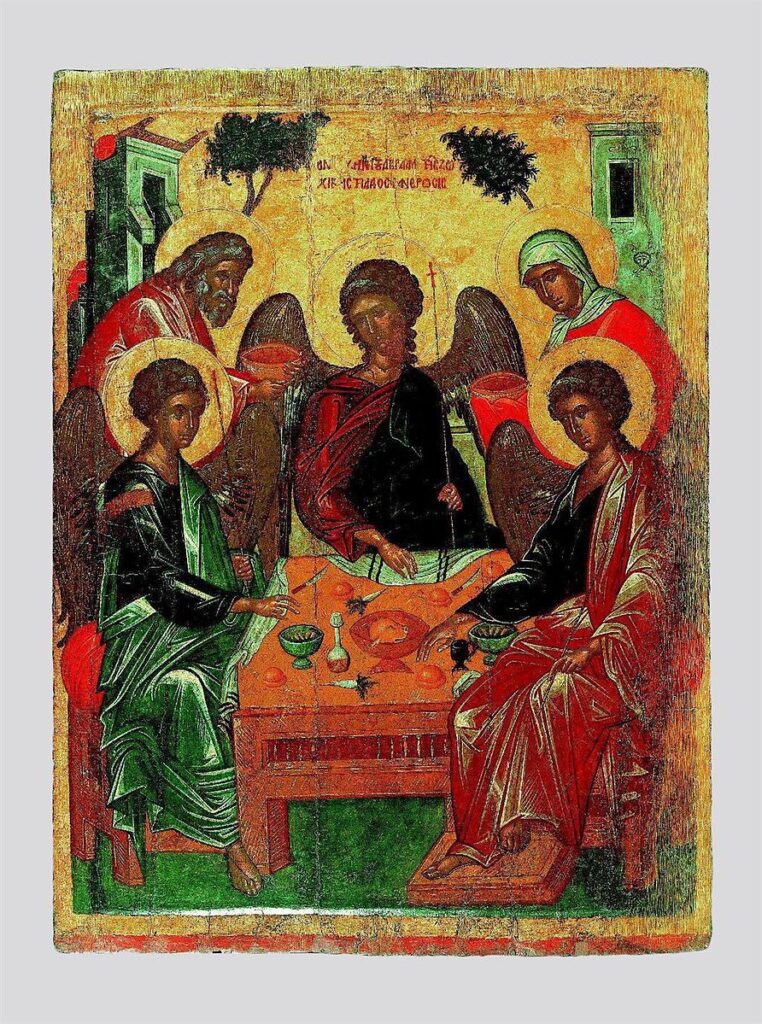
As much as we hear about the patriarchs of the Old Testament, the Bible also contains a good deal of information and stories about the women who walked beside them. For Isaac there is a Rebecca, and for Abram (or Abraham) there is a Sarai (or Sarah). These women each play a significant role in the history of salvation as wives and mothers in Jesus’ lineage. Sarah in particular foreshadows the virgin birth with her miraculous conception in old age. Her and Abraham’s famous hospitality toward their Lord has also been memorialized in trinitarian artwork for centuries.
Sarai appears by Abram’s side from the very beginning of where their story picks up in Genesis 12. These two, already advanced in years, were living in the land of Haran when God called Abram to leave his kindred for a foreign land with the promise of great blessings for his family and all who bless them, and thus in their old age the adventure began.
Faithful to the Lord, Abram and Sarai set out and took their nephew Lot with them along with all that they owned. A few mix-ups later—between Abram passing Sarai off as his sister to avoid conflict and Sarai trying to fulfill God’s promises by her own cunning—the Lord again visits the couple, giving them blessings and promises. God commands Abram (now Abraham) that Sarai shall no longer be Sarai but Sarah and tells him that she will bear a son. Additionally, he tells the patriarch that nations and kings will come from her fruitfulness.
Shortly thereafter, three men appeared near their tent. They are about to continue traveling onwards, but Abraham bids them to stay and sit while he and Sarah wait on them. In haste, Abraham and Sarah did just that, finding the choicest calf to prepare alongside Sarah’s fine-floured cakes, milk, and curds. All this they set before their visitors who imparted their knowledge to them: by this time the following year Sarah would have a son in her arms. Sarah laughs when she disbelieves that she could bear a child in her old age. Yet the Lord’s word comes true in the birth of their son Isaac, meaning “he laughs.”
Sarah’s earthly story ends in Genesis 23 when she dies at the age of 127, leaving Abraham to acquire land for her burial.

Brief History
Like the many other Old Testament saints of the sanctoral calendar, Sarah appears to be a more recent addition to the cycle and holds a unique date of January 20th on the Lutheran calendar. The date of her commemoration varies across other traditions (September 1st for the Roman Catholics and mid-December for the Eastern Orthodox).
However, her importance in the Lutheran church is evidenced not only by her inclusion in our sanctoral calendar but also and especially because of the ways in which her life provides for us an example of God’s will in our lives and the freedom he provides us. Just like Sarah, in baptism we are born into God’s covenant as free children who are given new names—new identities. Just as Sarah bears children through this freedom and covenant, our freedom and covenant with God also allows us to bear fruit. Paralleling God’s new covenant with his people, Sarah’s story reminds us that on our baptismal day we are brought forth as free children of God who are given a new name and a new life in him. Thus we give thanks for Sarah and the lessons that her life teaches us.

Collect
Hear us, O God, our Savior: so that we, who rejoice in the feast of Blessed Sarah, may learn from her the spirit of loving devotion; through Jesus Christ, Thy Son, our Lord, who liveth and reigneth with Thee and the Holy Ghost: ever one God, worth without end. Amen.
Lessons
First Lesson
Gospel
Resources
Propers found in Daily Divine Service Book: A Lutheran Daily Missal, edited by the Rev. Heath Curtis
References:
1. Weedon, William. Celebrating the Saints. Concordia Publishing House. 2016.
Images:
1. Abram and Lot Depart Out of Haran, illustrators of the 1728 Figures de la Bible, Gerard Hoet (1648–1733), 1728.
2. Hospitality of Abraham, Zakynthos, Byzantine, 15th century.
3. Abraham and Sarah Visited by Three Angels, anonymous ca. 1642.
Some links might be affiliate links which means we may receive a small commission at no extra cost to you. As an Amazon Associate we earn from qualifying purchases.



[…] the grand scheme of history, St. Sarah is a relatively recent addition to the sanctoral calendar. For this reason, the historic traditions […]